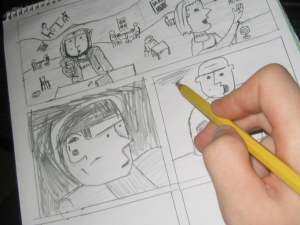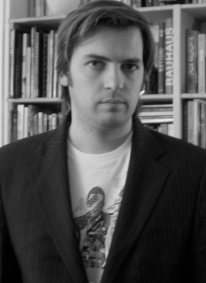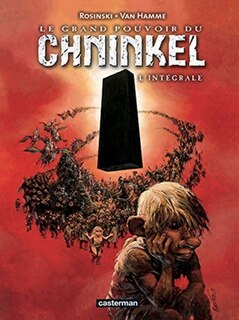Related Research Articles
Bandes dessinées, abbreviated BDs and also referred to as Franco-Belgian comics, are comics that are usually originally in French and created for readership in France and Belgium. These countries have a long tradition in comics, separate from that of English-language comics. Belgium is a bilingual country, and comics originally in Dutch are culturally a part of the world of bandes dessinées; these are translated to French and concurrently sold to the French-reading audience.

In comics studies, sequential art is a term proposed by comics artist Will Eisner to describe art forms that use images deployed in a specific order for the purpose of graphic storytelling or conveying information. The best-known example of sequential art is comics.

Comics is a medium used to express ideas with images, often combined with text or other visual information. It typically takes the form of a sequence of panels of images. Textual devices such as speech balloons, captions, and onomatopoeia can indicate dialogue, narration, sound effects, or other information. There is no consensus amongst theorists and historians on a definition of comics; some emphasize the combination of images and text, some sequentiality or other image relations, and others historical aspects such as mass reproduction or the use of recurring characters. Cartooning and other forms of illustration are the most common image-making means in comics; fumetti is a form that uses photographic images. Common forms include comic strips, editorial and gag cartoons, and comic books. Since the late 20th century, bound volumes such as graphic novels, comic albums, and tankōbon have become increasingly common, while online webcomics have proliferated in the 21st century.

Quebec comics are French language comics produced primarily in the Canadian province of Quebec, and read both within and outside Canada, particularly in French-speaking Europe.
The Prix de la critique is a prize awarded by the Association des Critiques et des journalistes de Bande Dessinée to the best comic album released for a year in France. Previously, from 1984 to 2003, it was called Prix Bloody Mary and awarded at the Angoulême International Comics Festival. Concerned at first with albums of the Franco-Belgian comics school it was eventually interested in works coming from the comic book tradition of more distant lands.
Jesús Blasco was a Spanish author and artist of comic books, whose career covered most of the conventional history of comic strips. He worked extensively in British comics in the 1960s and 1970s.
Les Humanoïdes Associés is a Franco-American publishing house specializing in comics and graphic novels, founded in December 1974 by comic artists Mœbius, Jean-Pierre Dionnet, Philippe Druillet, and financial director Bernard Farkas with the goal to publish the magazine Métal Hurlant,which focused on science fiction. It later expanded to include works from across comic book genres. Considered revolutionary in the comic book form at the time, chiefly due to its focus on the science fiction genre, the work found in Humanoïdes inspired many generations of authors and filmmakers.
Éditions Dupuis S.A. is a Belgian publisher of comic albums and magazines.

Thierry Smolderen is an essay writer, and a scenario writer of Belgian comic strips, for example of Gipsy.

Benoît Mouchart is a French writer and curator. From 2003 to 2013, he was artistic director of the cultural programming of Angoulême International Comics Festival, in France.

Guy Delcourt is a French editor, founder of the Delcourt publishing house in 1986. It has since grown into one of the largest publishers of comics in France.
Comics studies is an academic field that focuses on comics and sequential art. Although comics and graphic novels have been generally dismissed as less relevant pop culture texts, scholars in fields such as semiotics, aesthetics, sociology, composition studies and cultural studies are now re-considering comics and graphic novels as complex texts deserving of serious scholarly study.

Jean-Christophe Menu is a French underground cartoonist, graphic designer, comics scholar and publisher, son of the Egyptologist Bernadette Menu. He is best known for being one of the founders of L'Association, an influential comic book and art book publishing company from France often regarded as one of the key figures in the independent comic movement around the world.

Thierry Groensteen is one of the leading French-speaking comics researchers and theorists, whose work has found influence beyond that field.
The history of American comics began in the 19th century in mass print media, in the era of sensationalist journalism, where newspaper comics served as further entertainment for mass readership. In the 20th century, comics became an autonomous art medium and an integral part of American culture.

Francis Masse, known as Masse, is a French artist. In the early 1970s, he first became acquainted with his sculptures, then turned to animation and cartoon.

Ilan Manouach is an artist with a specific interest in conceptual and post-digital comics and is also active as a music performer, composer and a book publisher and has produced a few commissions for newspapers such as The New York Times and it:Internazionale (periodico). He currently holds a PhD researcher position at the New Media Programme of the Aalto University in Helsinki where he examines the intersections of contemporary comics, art and poetry. His work and research claims for the importance of comics as a materially self-reflexive medium, unaffiliated to any general art history. He has more than twenty published books, most of them published in the catalog of fr:La Cinquième Couche, and he has also produced solo exhibitions to important comics festivals, museums and galleries worldwide. His work has been written about in Hyperallergic, The Cut, World Literature Today, Wired, Le Monde, The Comics Journal, du9, 50 watts, Kenneth Goldsmith’s Wasting Time on the Internet and his works are also part of the UbuWeb online contemporary art archive.
Mira Falardeau is a French Canadian historian, professor, and author of comic strips. Falardeau has devoted works to Québec animated films, Québec comic strips and caricatures in Québec, focusing on visual humour in all its forms. She taught as a professor of cinema and communication at Laval University and the University of Ottawa. Falardeau has also curated exhibitions in the visual arts and operated a small publishing house.
Maurice Horn is a French-American comics historian, author, and editor, considered to be one of the first serious academics to study comics. He is the editor of The World Encyclopedia of Comics, The World Encyclopedia of Cartoons, and 100 Years of American Newspaper Comics. Born in France, he is based in New York City.

Chninkel or The Great Power of Chninkel is a Franco-Belgian comic with the story written by the Belgian writer Jean Van Hamme and the art drawn by the Polish artist Grzegorz Rosiński. First published from 1986 to 1987 in black and white, and later republished in color and translated to several languages, it mixes the genres of fantasy, science fiction and Biblical parables. It follows the adventures of a diminutive humanoid J'on, who suddenly finds himself tasked with saving the world. It has been called one of the first graphic novels in the history of Franco-Belgian comics.
References
- ↑ "Ann Miller". frenchculture.org. Retrieved 29 August 2022.
- 1 2 "Dr Ann Miller". University of Leicester. Retrieved 29 August 2022.
- 1 2 "Ann Miller". Comics Forum. Retrieved 29 August 2022.